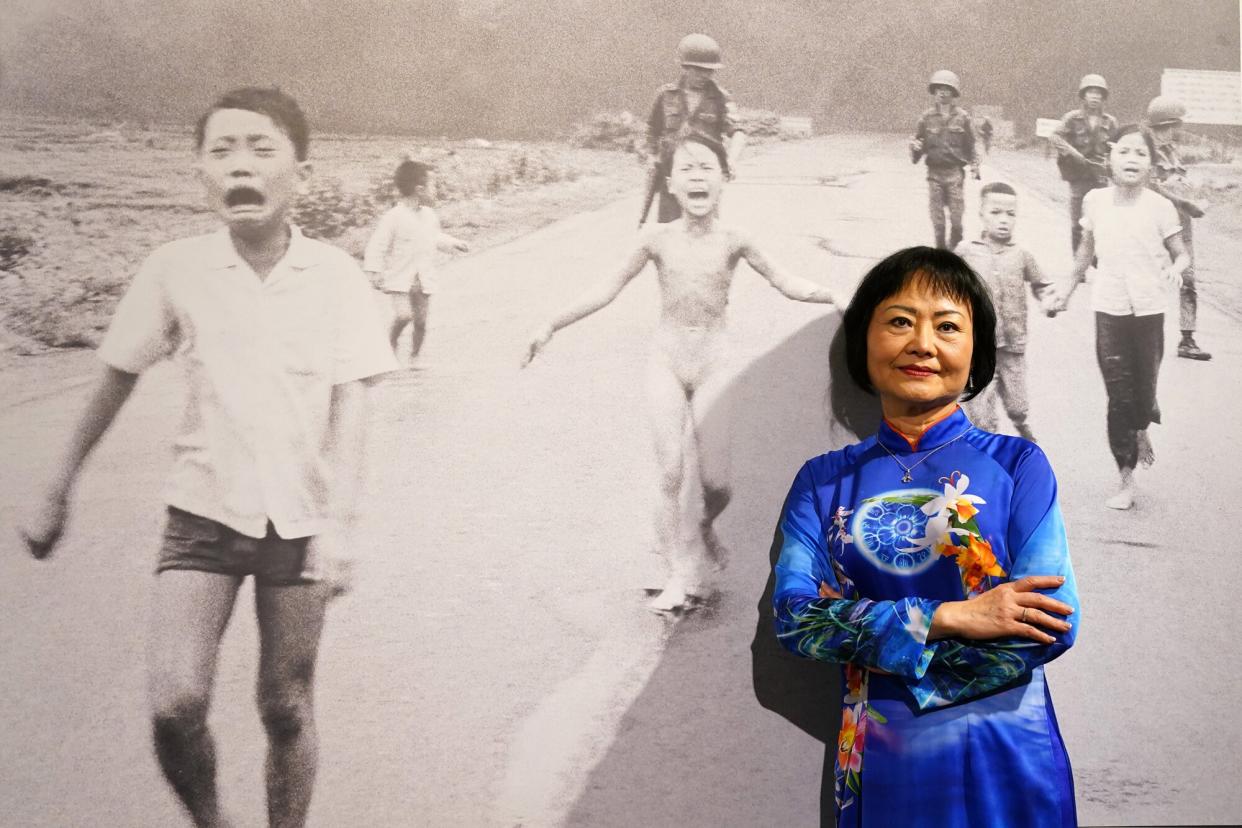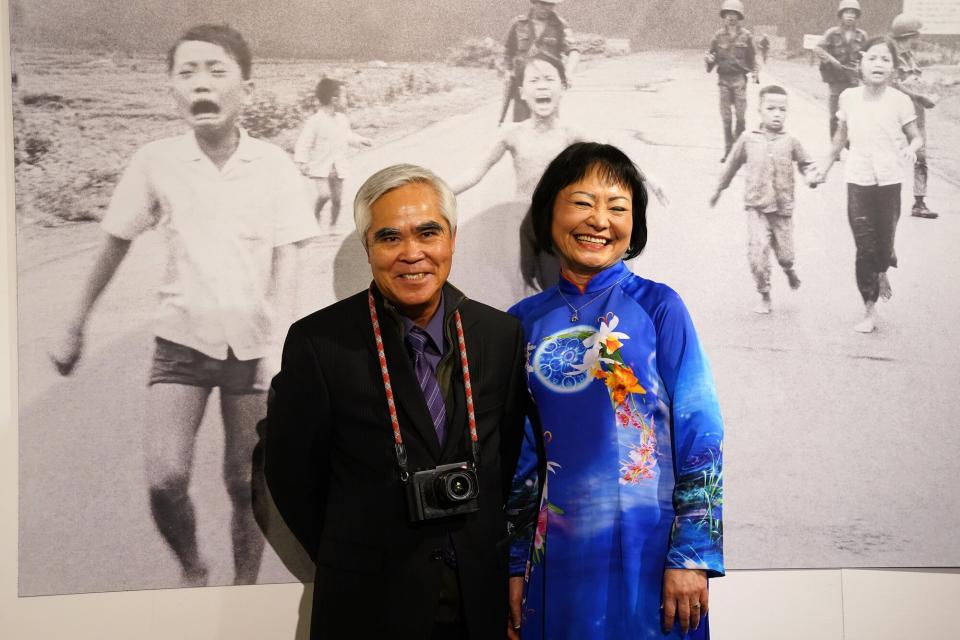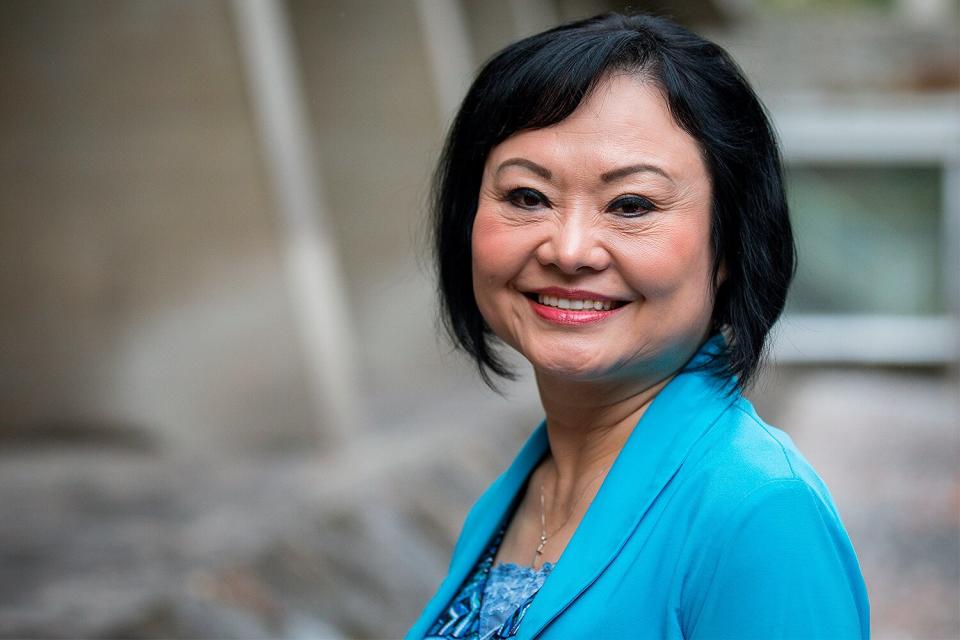50 Years After Defining Photo of Vietnam War, Kim Phuc Phan Thi Calls Burn Treatment 'a Miracle for Me'

- Oops!Something went wrong.Please try again later.
- Oops!Something went wrong.Please try again later.
Pier Marco Tacca/Getty
Fifty years after becoming an unwitting face of the atrocity of the Vietnam War, Kim Phuc Phan Thi is a UNESCO Goodwill Ambassador for Peace. She runs Kim Foundation International, which helps build hospitals, schools, orphanages and libraries for children. Most recently she accompanied refugees from Ukraine on their journey to resettle in Canada.
"I go everywhere that children need," she says of her global travels. "I share my story with students. I want them to know about how horrible war is but then how beautiful the world can be if everyone can learn to live with love, with hope and forgiveness."
She also recently completed yet another burn treatment, a continuation of years of healing.
It's an extraordinarily inspiring life no one could have predicted for the little Vietnamese girl famously caught up in the tragedy of the Vietnam war. Phan Thi was only 9 years old on June 8, 1972 when she was playing in the Cao Dai temple yard in Trang Bang, a small village outside Saigon, Vietnam, with her 3-year-old cousin Danh. South Vietnam soldiers arrived and yelled for the children to run.
"I saw the airplane (flying) toward me, very loud and very fast, and I just stood right there," recalls Phan Thi. "I turned my head, I looked up, and I saw four bombs, and I heard noises, and suddenly the fire was everywhere around us. Fire was falling out of the sky and hit me."
The fire burned her clothes off, and scalded her neck, back and left arm. When she tried to wipe the sticky napalm off her arm, she burned her right hand, too. "That moment, I still remember," says Phan Thi, now 59. "I was so scared. And I knew it, I got burned and I became ugly. A girl. And so people will see me a different way."
Nick Ut, a Vietnamese AP photographer, turned and saw Phan Thi and her brothers and cousins running for their lives. He captured their terror.

Pier Marco Tacca/Getty Photographer Nick Ut and Kim Phuc Phan Thi
Phan Thi was screaming "too hot, too hot," and soldiers gave her water to drink and then poured water on her burns, which inadvertently made them worse. When Phan Thi lost consciousness, Ut put down his camera and carried the little girl inside and eventually drove her to the hospital in Saigon. With 65% of her body badly burned and serious nerve damage, Phan Thi stayed in an American hospital for 14 months, undergoing 16 surgeries.
Ut's photograph sparked outrage in the United States. The bombs were mistakenly dropped by South Vietnamese on their own villagers, and the naked little "Napalm girl" and other children running down the street, their mouths agape, a black cloud behind them, shocked the American public. Here was proof that bombing civilian villages and terrorizing children was part of their war effort. The photograph is credited for changing the course of the war, and earned Ut a Pulitzer Prize. It also changed the course of Phan Thi's life.
At first, she felt ashamed. "When I saw the picture, you know, I was just a child," she says. "I thought 'Why didn't they protect me'? Why did he print that picture?' When I saw that ugly picture, I was naked. 'Why are my brothers and my cousin with clothes on?' "
During her time in the hospital she decided she wanted to become a doctor. Capping a childhood plagued by nightmares, scars, an inability to sweat because her pores were burned, and enduring unbearable pain when she made sudden movements or at times of changing weather, Phan Thi started medical school at age 19.
But because of her notoriety, the Vietnamese government forced her to participate in propaganda films that took too much time, so she had to leave school. She was devastated, full of anger and hate — and even contemplated suicide. She spent long hours in the library poring over religious texts. She found the new testament, became a Christian, and began to pray for peace.
"My enemies list became my prayer list," she says, and she gradually lost her anger and bitterness over what had been done to her. Eventually she went to Cuba to study Spanish, met her husband, and, on the way back from their honeymoon in Russia, defected to Canada.
Her health problems continued. She had difficulty moving her neck and lifting her left arm, and her left arm was much shorter than her right. In 1984 she traveled to Germany for surgery to restore movement and correct the imbalance. The surgery was successful but the pain lingered. Sometimes she rated it 10 out of 10 on the pain scale. Pain medication was her mainstay until she sought another way to manage it.

GEOFFROY VAN DER HASSELT/AFP via Getty
She learned to lessen the sharp pain from her burns with prayer, distracting herself, and applying pressure to the spot by leaning against the corner of a towel bar for prolonged periods of time. Despite a long list of physical issues, including asthma and diabetes, she was able to have two sons. She has always been open with them. "I tell them my story, but I never end in the middle," she says. "I always say your mom learned to forgive, to love people." Phan Thi also adopted a daughter, and she now has five grandchildren.
The sharp pain persisted, as if she was being cut with a knife. After a speaking engagement, someone in the audience told her about Dr. Jill Waibel, a dermatologist in Miami, Florida, and a pioneer in the laser treatment of scars. Dr. Waibel often treats burn survivors, and Phan Thi called her to see if she could help lessen her pain.
Dr. Waibel has now done a series of 12 treatments with Lumenis UltraPulse, the most powerful ablative laser available. Phan Thi is treated for 30 minutes with four to five lasers. The treatment requires separate lasers to take away the red, the white and the brown scars, and then bio-stimulators are injected to regrow skin.
Most patients stop after five to seven treatments, but Phan Thi can't always fit the week of recovery and healing into her schedule. "When Phan Thi shows up you never know if she's meeting the Pope the next day or the President," Dr. Waibel says. If she's too busy, treatment is lighter. By now, Phan Thi says, the pain is half of what was. She may go back for more treatments if she finds she needs them.
Although the treatments are difficult to endure, Phan Thi is ecstatic that they are working, and that the gains are permanent. "This is a miracle for me already," Phan Thi says. "I still have 4, 5, sometimes 3 (measure of pain on the pain scale). I can manage that. Before I met Jill, I wish that one day I'm in heaven, no more pain, no more scar. But now I enjoy (life). Every time I look at my scar, it looks much better, and less pain."
Dr. Waibel has secured donations of medicine for Phan Thi and performs the treatments pro bono. She is impressed with Phan Thi's fortitude. "Any of us couldn't survive one of the things she did and the hits just kept coming for her," she says. "She's mesmerizing. Her heart is so beautiful you just want to help her. Phan Thi is a survivor. I have never seen Phan Thi complain. She appreciates every moment of her life, and freedom."
Today Phan Thi looks at Ut's photograph and finds reasons to be thankful. "It was really a miracle (I was burned) on my back and not in the front," she says, adding, "Even (though) I got burned all over, my feet weren't burned, so I was able to run out of that fire."
"The challenge to everyone is: If that little girl can do it, everyone can do it," she says. "You don't have to wait until you are somebody, do something. No, (that's) too late already. Be yourself and be a blessing."
"'I am sure you can make a difference' — that's what I tell the children. Very simple, from my heart. Every child, it doesn't matter how old, they know, they understand me."

